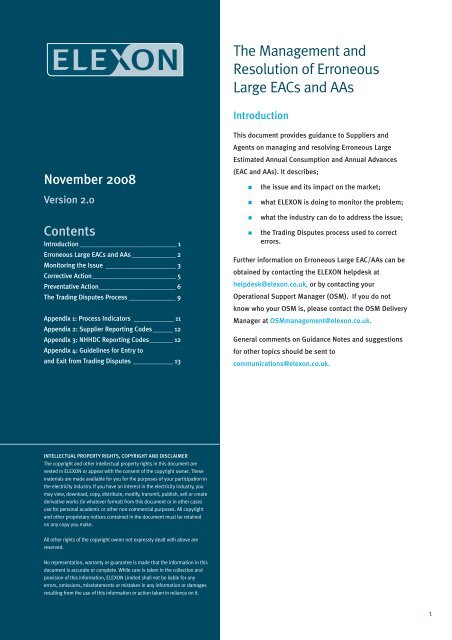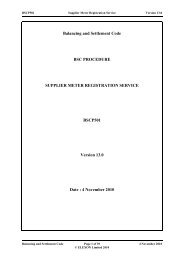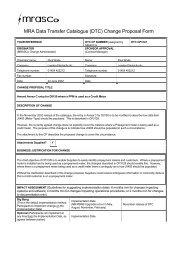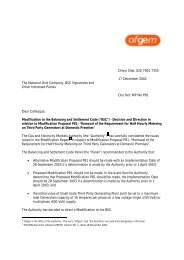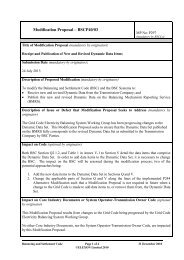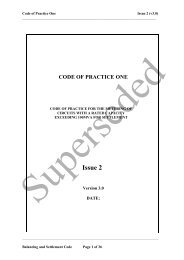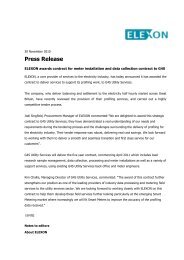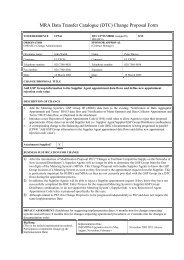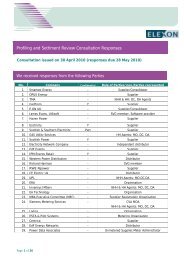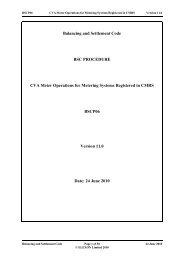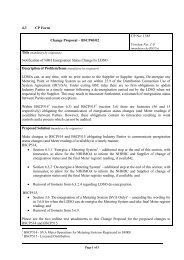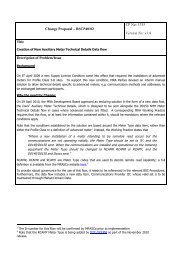The Management and Resolution of Large EACs and AAs - Elexon
The Management and Resolution of Large EACs and AAs - Elexon
The Management and Resolution of Large EACs and AAs - Elexon
Create successful ePaper yourself
Turn your PDF publications into a flip-book with our unique Google optimized e-Paper software.
<strong>The</strong> <strong>Management</strong> <strong>and</strong><strong>Resolution</strong> <strong>of</strong> Erroneous<strong>Large</strong> <strong>EACs</strong> <strong>and</strong> <strong>AAs</strong>IntroductionNovember 2008Version 2.0ContentsIntroduction _____________________________ 1Erroneous <strong>Large</strong> <strong>EACs</strong> <strong>and</strong> <strong>AAs</strong> _____________ 2Monitoring the Issue _____________________ 3Corrective Action_________________________ 5Preventative Action_______________________ 6<strong>The</strong> Trading Disputes Process ______________ 9Appendix 1: Process Indicators ____________ 11Appendix 2: Supplier Reporting Codes ______ 12Appendix 3: NHHDC Reporting Codes_______ 12Appendix 4: Guidelines for Entry to<strong>and</strong> Exit from Trading Disputes ____________ 13This document provides guidance to Suppliers <strong>and</strong>Agents on managing <strong>and</strong> resolving Erroneous <strong>Large</strong>Estimated Annual Consumption <strong>and</strong> Annual Advances(EAC <strong>and</strong> <strong>AAs</strong>). It describes;■■■■the issue <strong>and</strong> its impact on the market;what ELEXON is doing to monitor the problem;what the industry can do to address the issue;the Trading Disputes process used to correcterrors.Further information on Erroneous <strong>Large</strong> EAC/<strong>AAs</strong> can beobtained by contacting the ELEXON helpdesk athelpdesk@elexon.co.uk, or by contacting yourOperational Support Manager (OSM). If you do notknow who your OSM is, please contact the OSM DeliveryManager at OSMmanagement@elexon.co.uk.General comments on Guidance Notes <strong>and</strong> suggestionsfor other topics should be sent tocommunications@elexon.co.uk.INTELLECTUAL PROPERTY RIGHTS, COPYRIGHT AND DISCLAIMER<strong>The</strong> copyright <strong>and</strong> other intellectual property rights in this document arevested in ELEXON or appear with the consent <strong>of</strong> the copyright owner. <strong>The</strong>sematerials are made available for you for the purposes <strong>of</strong> your participation inthe electricity industry. If you have an interest in the electricity industry, youmay view, download, copy, distribute, modify, transmit, publish, sell or createderivative works (in whatever format) from this document or in other casesuse for personal academic or other non-commercial purposes. All copyright<strong>and</strong> other proprietary notices contained in the document must be retainedon any copy you make.All other rights <strong>of</strong> the copyright owner not expressly dealt with above arereserved.No representation, warranty or guarantee is made that the information in thisdocument is accurate or complete. While care is taken in the collection <strong>and</strong>provision <strong>of</strong> this information, ELEXON Limited shall not be liable for anyerrors, omissions, misstatements or mistakes in any information or damagesresulting from the use <strong>of</strong> this information or action taken in reliance on it.1
Erroneous <strong>Large</strong> EACS <strong>and</strong> AASBackgroundAn average domestic customer (on Pr<strong>of</strong>ile Class 1) uses about 3,500 kWh per year or approximately 10 units a day.Most domestic customers will use less than 25,000 units per year. A 100kW business customer (on Pr<strong>of</strong>ile Class 8)who maintained full load for the entire year (a theoretical situation, never achieved in real life) would use:100kW x 8760 hrs = 876,000 kWhHowever, we have discovered many <strong>EACs</strong> <strong>and</strong> <strong>AAs</strong> that are tens <strong>of</strong> millions in size - consumption more common forSteel Works. <strong>The</strong>se <strong>EACs</strong> <strong>and</strong> <strong>AAs</strong> are unlikely to reflect the actual consumption. Not only is the consumptionunrealistic, the distribution network infrastructure would not support such dem<strong>and</strong>s. <strong>The</strong>se excessive values do notoccur very <strong>of</strong>ten but their size makes their impact on Supplier Volume Allocation (SVA) significant.To identify excessive consumption, ELEXON produced a set <strong>of</strong> thresholds above which Erroneous <strong>Large</strong> <strong>EACs</strong> <strong>and</strong> <strong>AAs</strong>can be identified. <strong>The</strong> thresholds are set per Pr<strong>of</strong>ile Class <strong>and</strong> represent a kWh per register per year value. For eachPr<strong>of</strong>ile Class there is also a negative threshold below which negative Erroneous <strong>Large</strong> <strong>EACs</strong> <strong>and</strong> <strong>AAs</strong> can be identified.Consumption that exceeds ELEXON’s consumption thresholds is not necessarily wrong. <strong>The</strong>re may be genuineconsumption above the thresholds, conversely there may be erroneous large consumption below these thresholds.Figure 1: Excessive Consumption Thresholds by Pr<strong>of</strong>ile ClassPr<strong>of</strong>ile ClassDescriptionUpperThreshold (kWh/Year/Register)Lower1 Domestic Unrestricted 160,000 -50,0002 Domestic with Switched load 110,000 -50,0003 Non-Domestic Unrestricted 200,000 -50,0004 Non-Domestic with Switched load 140,000 -50,0005 Load Factor < 20% 220,000 -50,0006 Load Factor 20% to 30% 320,000 -50,0007 Load Factor 30% to 40% 430,000 -50,0008 Load Factor > 40% 690,000 -50,000HistoryWe identified the issue <strong>of</strong> Erroneous <strong>Large</strong> <strong>EACs</strong> <strong>and</strong> <strong>AAs</strong> in Settlement in 2000. <strong>The</strong> issue was <strong>of</strong> sufficient materialityto contribute to a qualified BSC Audit Opinion. In April 2000, the Pool Executive Committee (PEC) <strong>and</strong> Trading Stage 2Committee (TS2) authorised the processing <strong>of</strong> Post-Final (DF) Settlement Runs to correct Settlement data. DF runsstarted in July 2000. It was agreed to use the disputes process to re-run Settlement until the issue was “substantiallyaddressed within the Final Reconciliation Runs”. Eight years later, DF Settlement Runs are still processed in most GSPGroups. Erroneous <strong>Large</strong> <strong>EACs</strong> <strong>and</strong> <strong>AAs</strong> are a major Settlement issue <strong>and</strong> appear on the BSC Auditor’s Statement <strong>of</strong>Significant Matters.<strong>The</strong> Settlement Impact <strong>of</strong> Erroneous <strong>Large</strong> <strong>EACs</strong> <strong>and</strong> <strong>AAs</strong>Erroneous <strong>Large</strong> <strong>EACs</strong> <strong>and</strong> <strong>AAs</strong> can significantly impact Suppliers. At a market level, error is absorbed through theapplication <strong>of</strong> Group Correction Factor. <strong>The</strong> issue affects Suppliers through the misallocation <strong>of</strong> the error duringSupplier Volume Allocation. Erroneous <strong>Large</strong> <strong>EACs</strong> <strong>and</strong> <strong>AAs</strong> distort a Supplier’s share <strong>of</strong> the market consumption.Suppliers pay for any resulting erroneous electricity consumption <strong>and</strong> also face additional cost through higherDistribution Use <strong>of</strong> System (DUoS) <strong>and</strong> Transmission Network Use <strong>of</strong> System (TNUoS) charges.2
Monitoring the IssueELEXON’s <strong>Large</strong> EAC/AA SystemELEXON has built a system to monitor the issue <strong>and</strong> provide reporting to Panel Committees <strong>and</strong> the industry. <strong>The</strong> <strong>Large</strong>EAC/AA system uses data collected from Non Half Hourly Data Aggregators (NHHDAs), Suppliers <strong>and</strong> Non Half HourlyData Collectors (NHHDCs). Data is collected monthly before running the system. <strong>The</strong> monthly process is illustrated infigure 2 below.<strong>The</strong> primary information is obtained from NHHDA databases. Each NHHDA, using consistent interrogation scriptsprovides us with details <strong>of</strong> all consumption values above the agreed <strong>Large</strong> EAC/AA thresholds (see figure 1 above). Thisinformation is provided each month <strong>and</strong> processed by the <strong>Large</strong> EAC/AA system. <strong>The</strong> system compiles a complete list<strong>of</strong> the instances <strong>of</strong> excessive consumption that currently exist in NHHDA.From the outputs provided, Suppliers <strong>and</strong> NHHDCs can notify us <strong>of</strong> consumption values they believe are genuine. <strong>The</strong>Supplier/NHHDC can notify us that a specific value (EAC or AA) is correct <strong>and</strong> provide a reason why that MeteringSystem genuinely consumes over the threshold. Instances <strong>of</strong> genuine high consumption confirmed by the relevantSupplier are removed from materiality calculations. High consumptions that are confirmed by NHHDCs are noted by thesystem but are included in materiality calculations until also confirmed by the relevant Supplier.Figure 2: <strong>The</strong> <strong>Large</strong> EAC/AA System <strong>and</strong> the Monthly ProcessNHHDANHHDC<strong>Large</strong> EAC/AAextract<strong>Large</strong> EAC/AAInstance ReportELEXONIndustry ReportingSupplierConfirmation <strong>of</strong>validconsumption<strong>The</strong> <strong>Large</strong> EAC/AA system is the data source for all the reports that ELEXON produces on the issue. We produce anumber <strong>of</strong> st<strong>and</strong>ard monthly reports on the Erroneous <strong>Large</strong> EAC/AA issue including:■ <strong>The</strong> Instance Report - A report for Suppliers <strong>and</strong> NHHDCs identifying all instances <strong>of</strong> large <strong>EACs</strong> <strong>and</strong> <strong>AAs</strong>that exist in Settlement. <strong>The</strong> Instance Report is explained in more detail later inthis section.■ <strong>The</strong> Summary Report - A report for Suppliers <strong>and</strong> NHHDCs that shows the gross error associated with theidentified erroneous instances.■ TDC Graphs - Graphs showing the Supplier Energy Allocation Error (SEAE) by GSP Group for eachSettlement month. <strong>The</strong>se are used to authorise DF Settlement Runs. <strong>The</strong> TradingDisputes Process is described later in this guidance note.■ Materiality reporting - A report for Suppliers <strong>and</strong> the Performance Assurance Board (PAB). <strong>The</strong>se showgross error figures by Supplier <strong>and</strong> are used to monitor performance.3
Measures <strong>of</strong> Materiality – SEAE <strong>and</strong> GUEEELEXON uses two measures to report the <strong>Large</strong> EAC/AA issue: Supplier Energy Allocation Error (SEAE) <strong>and</strong> GrossUncorrected Energy Error (GUEE). Both measures are produced by the <strong>Large</strong> EAC/AA model. SEAE is a measurement toshow the Settlement impact on Suppliers. It incorporates the effects <strong>of</strong> GSP Group Correction Factors <strong>and</strong> the netting <strong>of</strong>positive <strong>and</strong> negative errors within the Supplier calculations. GUEE indicates the extent <strong>of</strong> the issue in terms <strong>of</strong> theamount <strong>of</strong> energy that is incorrect. It does not net positive <strong>and</strong> negative values <strong>and</strong> does not take into account theeffects <strong>of</strong> GSP Group Correction Factor.SEAE is used by the Auditor as a primary measure <strong>of</strong> materiality. <strong>The</strong> materiality reports use GUEE because Supplierscan measure reductions in gross error without reference to the errors produced by other Suppliers.<strong>The</strong> Instance Report<strong>The</strong> Instance Report (xxxx_instance.csv) details, for a given Supplier or NHHDC all the <strong>EACs</strong> <strong>and</strong> <strong>AAs</strong> that exist inNHHDA that are above ELEXON’s excessive consumption thresholds (see figure 1). Its purpose is to inform Suppliers<strong>and</strong> NHHDCs <strong>of</strong> the errors that need to be addressed.For each large EAC or AA identified on the Instance Report full Settlement details are provided; GSP Group, NHHDC ID,Supplier ID, MSID, Pr<strong>of</strong>ile Class, SSC ID, TPR ID, Effective From Settlement Date <strong>and</strong> Effective to Settlement Date. Inaddition, the Report contains several additional system assigned fields. <strong>The</strong>se are:■ EAC/AA Indicator Indicates whether the consumption is an EAC (E) or an AA (A).■ Start / End Date <strong>The</strong>se indicate the dates where the instance is being used in Settlement. This will notnecessarily be the same as the Effective to <strong>and</strong> From Dates.■ Excessive <strong>The</strong> annual consumption value <strong>of</strong> the EAC or AA.■ Realistic A realistic consumption value for the MSID. Where provided by the Supplier this willbe the Annual Billed Units, otherwise a Class Average EAC will be used.■ Process Indicator This is assigned by the system <strong>and</strong> indicates the ELEXON view <strong>of</strong> the consumption,whether genuine or erroneous. Process indicators range from 0 – 10. Processindicators 0, 6, 8 <strong>and</strong> 9 are treated as erroneous, all others are considered to begenuine. Appendix 1 includes a complete breakdown.■ Impact Indicator A rough Settlement impact – this has been replaced by the EAC/AA Materialitycalculator (see later).■ Significance Flag This column indicates whether the instance contributes to the top 50% <strong>of</strong> error.Identify Genuine Consumption<strong>The</strong>re are a number <strong>of</strong> secondary issues that result in genuine <strong>EACs</strong> <strong>and</strong> <strong>AAs</strong> above the ELEXON thresholds; thisincludes incorrect Measurement or Pr<strong>of</strong>ile Class, Erratic Consumption, or a Long period <strong>of</strong> Estimated Consumption.<strong>The</strong> Instance Report contains a complete list <strong>of</strong> all <strong>EACs</strong> <strong>and</strong> <strong>AAs</strong> in NHHDA that exceed the <strong>Large</strong> EAC/AA thresholds.This will include instances where the consumption is genuine. It is important that Suppliers <strong>and</strong> NHHDCs informELEXON <strong>of</strong> genuine consumption to ensure the resulting monitoring information is accurate. We ask Suppliers <strong>and</strong>NHHDCs to submit an Excel file to ELEXON each month confirming any consumption on the Instance report they believeis genuine. An appropriate confirmation code should be used. A different set <strong>of</strong> codes are used for Suppliers <strong>and</strong>NHHDCs. <strong>The</strong>se are in Appendix 2 <strong>and</strong> 3. Suppliers can delegate the confirmation <strong>of</strong> genuine consumption to theiragents. This process is called “Delegated Authority”. Please inform ELEXON if this is required.Once a Metering System has been identified as being on the wrong Pr<strong>of</strong>ile Class or Measurement Class <strong>and</strong> theinstances flagged as genuine, they are not included in the materiality calculations. <strong>The</strong> secondary issue should still beaddressed. Advice <strong>and</strong> guidance for this is on the ELEXON website: http://www.elexon.co.uk/Publications/notes/.For repeatedly flagged genuine instances, Suppliers can also notify ELEXON <strong>of</strong> annual billed units. <strong>The</strong>se can be usedto validate future excessive instances that occur for the same metering system. If any excessive instance is less thantwice the annual billed units for that Metering System, the new instance will be confirmed as genuine <strong>and</strong> removedfrom any materiality calculations. This prevents Suppliers from repeatedly confirming instances for Metering Systemswith consistently excessive consumption.Instances will continue to be reported so long as they remain in the NHHDA database. Suppliers <strong>and</strong> agents need toadopt procedures to recognise reporting occurrences <strong>of</strong> high but genuine consumption (where the ELEXON system isnot able to do so automatically).4It is likely that the BSC Auditor will check that any excessive EAC/<strong>AAs</strong> excluded from the materiality calculations havebeen excluded on reasonable grounds. Keep appropriate audit trails <strong>and</strong> make them available when you are audited.
Corrective ActionWork <strong>Management</strong>Correcting Erroneous <strong>Large</strong> <strong>EACs</strong> <strong>and</strong> <strong>AAs</strong> is <strong>of</strong>ten a lengthy process <strong>and</strong> involves cooperation between Suppliers <strong>and</strong>Agents. Effectively managing corrective activity is crucial. Monitoring systems should include an action tracking <strong>and</strong>escalation process to ensure resolutions are successful. <strong>The</strong> ELEXON Instance Report is a useful check <strong>of</strong> whetherinstances have been successfully cleared from NHHDA. <strong>The</strong> instance report can be the basis for managing correctiveaction. This can be enhanced by adding additional columns or by developing applications / databases into which theinstance report can be loaded.Managing Erroneous <strong>Large</strong> <strong>EACs</strong> <strong>and</strong> <strong>AAs</strong> is a largely manual process where staff have specialised skills. It isimportant to capture <strong>and</strong> document processes in Local Working Practices (LWIs) to ensure that the knowledge base isnot hindered by staff turn over.Prioritisation<strong>The</strong> Instance Report will in most cases contain a large number <strong>of</strong> instances. It includes all excessive consumption thatexists in NHHDA databases. This includes instances that have crystallised <strong>and</strong> those that have previously beenconfirmed as genuine consumption. <strong>The</strong>re are about 6,000 Erroneous <strong>Large</strong> <strong>EACs</strong> <strong>and</strong> <strong>AAs</strong> in the market at any time,compared to some 200,000 that will be reported in total. It is crucial that Suppliers <strong>and</strong> NHHDCs can identify <strong>and</strong>prioritise corrective action.All instances with a process indicator 0, 6, 8 or 9 are considered to be erroneous. <strong>The</strong> remaining process indicators(1, 2, 3, 4, 5, 7 <strong>and</strong> 10) indicate that we consider the consumption to be genuine. Suppliers <strong>and</strong> NHHDCs need to focus onthe erroneous process indicators. Suppliers also need focus on <strong>EACs</strong> <strong>and</strong> <strong>AAs</strong> that are affecting fluid Settlement Datesthat haven‘t passed the last reconciliation (DF for GSP Groups in the Trading Disputes Process, RF for the remainder).Suppliers <strong>and</strong> NHHDCs should be left with a manageable number <strong>of</strong> Erroneous <strong>Large</strong> <strong>EACs</strong> <strong>and</strong> <strong>AAs</strong> to resolve. Of theseit is likely that a small proportion <strong>of</strong> very large instances will cause the majority <strong>of</strong> the error. Typically about 20% <strong>of</strong> theinstances will cause 80% <strong>of</strong> the total error. Correcting Erroneous <strong>Large</strong> <strong>EACs</strong> <strong>and</strong> <strong>AAs</strong> is largely a manual process. It istherefore important that Suppliers <strong>and</strong> NHHDCs prioritise which they focus on.Suppliers <strong>and</strong> NHHDCs should aim to resolve all error before it crystallises. It is therefore essential to prioritiseinstances approaching the relevant last reconciliation Run whether RF or DF. Suppliers should also focus on instancesthat have the largest Settlement impact. This will depend on the size <strong>of</strong> the excessive consumption <strong>and</strong> the length <strong>of</strong>the meter advance. Suppliers <strong>and</strong> NHHDCs should have a system for prioritising that takes into account SettlementImpact <strong>and</strong> the time until crystallisation.We have created a tool to use in conjunction with the Instance Report to prioritise work. This is called the <strong>Large</strong>EAC/AA Materiality Calculator. Please contact the ELEXON Helpdesk to request this.<strong>The</strong> calculator recreates ELEXON’s error materiality calculation for any Erroneous <strong>Large</strong> <strong>EACs</strong> <strong>and</strong> <strong>AAs</strong> in the InstanceReport. It does so for any given range <strong>of</strong> Settlement Dates. <strong>The</strong> result is a total positive or negative for the givenperiod. This can be sorted to identify the MSIDs contributing the greatest error.Data Cleansing<strong>The</strong> method for cleansing erroneous <strong>EACs</strong> <strong>and</strong> <strong>AAs</strong> is defined by BSCP504: Non-Half Hourly Data Collection for SVAMetering System Registered in SMRS. <strong>The</strong> corrective approach depends on a number <strong>of</strong> factors, including whether theexcessive EAC/AA was caused by an invalid Change <strong>of</strong> Supplier (CoS) reading <strong>and</strong> if any part <strong>of</strong> the excessive EAC/AAis crystallised in Settlement.<strong>The</strong> rules for deciding what data cleansing approach to take are complicated. An audit trail must be maintainedirrespective <strong>of</strong> the approach taken.Incorrectly Processed ReadingsIf the reading is valid but it has been incorrectly processed to give erroneous EAC/<strong>AAs</strong> (for example in anincorrectly identified meter rollover scenario) <strong>and</strong> these erroneous EAC/<strong>AAs</strong> have not been used in the lastreconciliation <strong>of</strong> a Settlement Date, correctly re-process the reading.Invalid Non-CoS ReadingsIf the EAC/<strong>AAs</strong> derived from the invalid reading were not used in the last reconciliation <strong>of</strong> any SettlementDate, the invalid reading should be withdrawn. Once withdrawn, re-process subsequent readings. It isimportant to check the subsequent readings don’t generate further erroneous large <strong>EACs</strong> or <strong>AAs</strong>. 5
Invalid CoS ReadingWhen an invalid CoS reading occurs, Suppliers can agree a revised reading through the Disputed Readprocess. If the agreed revised reading is reasonable, this should be processed.Suppliers <strong>and</strong> their NHHDCs should ensure that an Erroneous <strong>Large</strong> EAC/AA, caused by an invalid change <strong>of</strong>Supplier reading, is resolved before the EAC/AA is used in the last reconciliation <strong>of</strong> a Settlement Date. Whenthe erroneous CoS reading is subject to the large EAC/AA Trading dispute, the Supplier can use the DF periodto withdraw <strong>and</strong> correct the erroneous CoS reading.Part Crystallised ConsumptionIf an Erroneous <strong>Large</strong> EAC or AA is part crystallised in Settlement, Gross Volume Correction can be applied tominimise its impact in the fluid period. Gross Volume Correction (GVC) is a complex process described insection 4.14 <strong>of</strong> BSCP504. A GVC Guidance Note is also available from the Publications section <strong>of</strong> the ELEXONwebsite. Measures should be made such that errors are corrected prior to the last reconciliation run <strong>and</strong> GVCis not necessary. It should be noted that GVC can not be used to compensate for consumption that hascompletely crystallised in Settlement.Preventative ActionAccurate Meter ReadingMeter read quality is fundamental to reducing the number <strong>of</strong> Erroneous <strong>Large</strong> <strong>EACs</strong> <strong>and</strong> <strong>AAs</strong>. Accurate <strong>and</strong> frequentmeter reads ensures the simplicity <strong>of</strong> the remainder <strong>of</strong> the process. Initial investment in training meter readers <strong>and</strong>developing high quality systems to support them can lead to lower running costs <strong>and</strong> better performance figures.Training <strong>of</strong> meter readers should include an overview <strong>of</strong> the entire process instilling a good underst<strong>and</strong>ing <strong>of</strong> theimplications <strong>of</strong> incorrect readings. This should include errors in customer bills, Settlement <strong>and</strong> Distribution Use <strong>of</strong>System (DUoS) charging.Training <strong>and</strong> incentive schemes should focus on quality as well as quantity. This should be reflected in performancemeasures.Monitoring should trap repeated errors, e.g. registers entered in the wrong order, tenth digit included <strong>and</strong> wrongmeters read in multi-meter installations. <strong>The</strong> meter reader’s identifier should be attached to the readings to supportthe monitoring process. Results can be fed back to the meter reader <strong>and</strong> incorporated into future training.All meter readers’ reports must be reviewed <strong>and</strong> passed to the appropriate area for action. If they contain informationnecessary to successful reading <strong>of</strong> the meter, this should be available to future readers.On-site ValidationSome human error is unavoidable. NHHDC systems can identify erroneous meter readings. On-site controls in datacollection h<strong>and</strong> held units can confirm the readings entered are accurate. However, they cannot confirm that theadvance generated is valid as this requires additional information only available in the NHHDC’s main systems. Werecommend that on-site validation is used to complement, rather than as a substitute for, validation performed in themain systems.Entry <strong>of</strong> meter readings that give rise to advances outside the expected range (half to twice the expected advance)should require positive verification, for example, re-keying the reading <strong>and</strong> entering the meter serial number. <strong>The</strong>reshould be additional safeguards where the reading is completely inconsistent with the expected value (e.g. five timesthe expected value or a credit reading).System ValidationNHHDC systems should include tight controls against erroneous readings. <strong>The</strong>se should incorporate;Reasonableness ChecksReasonableness checks are incorporated into the EAC/AA calculation s<strong>of</strong>tware used by NHHDCs. <strong>The</strong> defaulttolerance thresholds are used in ELEXON’s monitoring <strong>of</strong> the issue <strong>and</strong> are shown in Figure 1. <strong>The</strong> thresholdscan be lowered by NHHDCs to investigate consumption below the threshold. We recommend this is done onlywhen the levels <strong>of</strong> exceptions above the thresholds are sufficiently reduced.6
Associated changes to the BSCPs <strong>and</strong> Party Service Lines place obligations on NHHDCs to investigate all <strong>AAs</strong>exceeding the tolerances, <strong>and</strong> report actions to resolve the exception to the relevant Supplier. As the EAC/AAdatabase does not include Supplier details, NHHDCs will need to process further the exception log <strong>of</strong>excessively large <strong>AAs</strong> produced by the EAC/AA s<strong>of</strong>tware. <strong>The</strong> exceptions can be distributed to the relevantSuppliers <strong>and</strong> the status <strong>of</strong> each reported following initial investigation.Expected Reading CalculationMeter read validation should include a comparison <strong>of</strong> the calculated meter advance with the expectedadvance. <strong>The</strong> reading is rejected when the difference between the calculated advance <strong>and</strong> the expectedadvance exceeds the tolerance. This process relies on reasonable accuracy <strong>of</strong> the expected advance.Some NHHDCs cannot always establish a reasonably accurate expected advance. This is <strong>of</strong>ten due toincorrectly migrated data, incorrect initial <strong>EACs</strong>, lack <strong>of</strong> consumption history <strong>and</strong>/or incorrect acceptance <strong>of</strong> aprevious reading.We recommend that NHHDCs review their method <strong>of</strong> establishing the expected advance. Ideally, it should becalculated using the current EAC <strong>and</strong> pr<strong>of</strong>ile data, although any equivalent process can be used. Whencalculating expected values before pr<strong>of</strong>ile data is produced, use substitute pr<strong>of</strong>ile data from the previous year.For new connections, it is important to establish an expected consumption to calculate an expected advance.NHHDCs <strong>and</strong> Suppliers must provide a realistic initial EAC for this.Supplier FeedbackWe advise Suppliers to feedback to the NHHDC when readings the NHHDC mark as valid are not accurateenough for Supplier billing. <strong>The</strong> NHHDC can then consider withdrawing the reading from Settlement.Conversely, provide feedback when readings marked as invalid by the NHHDC are accurate enough forSupplier billing. In these situations the NHHDC should not automatically accept the reading. Instead thereading should be reviewed, taking the Supplier feedback into consideration, <strong>and</strong> should only enterSettlement if the reviewer is satisfied that it is correct. It may be appropriate to accept a reading thatgenerates a meter advance three times the expected advance on the basis <strong>of</strong> the Supplier’s feedback. It isn’tappropriate to accept a reading that generates a meter advance <strong>of</strong> one hundred times the expected advance,solely on the basis <strong>of</strong> the Supplier’s feedback.Review <strong>of</strong> Suspect ReadingsWhere a reading fails automated validation, it can be overridden via a manual review process. It is important that thisprocess is robust <strong>and</strong> readings aren‘t accepted too readily. For example, if a NHHDC is under pressure (e.g. throughcommercial incentives) to progress as many readings as possible to help the Supplier achieve performance levels forthe Energy on actual meter readings (serial SP08), this can result in poor readings going through the suspect readingreview process. Suppliers should incentivise the quality as well as the quantity <strong>of</strong> readings.It is important that reviewers have enough information to determine whether readings are genuine. This includes acomplete history <strong>of</strong> Meter Readings <strong>and</strong> the associated <strong>EACs</strong> <strong>and</strong> <strong>AAs</strong> for each register on the Metering System. It isalso useful to have a record <strong>of</strong> what type <strong>of</strong> reading each is, for example, Deemed, Customer Own Reads or corrective(GVC). Where possible, Supplier billed units, the business type <strong>and</strong> details <strong>of</strong> any previous Change <strong>of</strong> Agent or Supplieractivity are a useful resource.Common IssuesFilters have an important role in preventing Erroneous <strong>Large</strong> <strong>EACs</strong>/<strong>AAs</strong> from entering Settlement. However, they onlyremove the main symptom <strong>of</strong> the problem – the Erroneous <strong>Large</strong> <strong>EACs</strong>/<strong>AAs</strong> – they do not address the root cause. It isimportant that root causes are identified <strong>and</strong> addressed. NHHDC systems should contain feedback loops to correcterrors that led to Erroneously <strong>Large</strong> <strong>EACs</strong>/<strong>AAs</strong>. If they don’t, the NHHDC system is left with an invalid reading, anincorrect expectation for the next advance <strong>and</strong> is out <strong>of</strong> step with the NHHDA system.For all exceptions identified by filters it is important that NHHDCs resolve the instance moving forward. Identified rootcauses should be investigated <strong>and</strong> preventative controls put in place. Some known issues include:Switched RegistersIt is common that Meter readings on multi-register Meters are switched over by the Meter Reader. This <strong>of</strong>tenleads to the generation <strong>of</strong> two erroneous large <strong>AAs</strong>. In this case the readings can be switched back <strong>and</strong> revalidated- described in BSCP504 section 4.6.7
Our analysis has shown that multi-register Meters, while accounting for only 20% <strong>of</strong> the market, contributealmost half <strong>of</strong> the Erroneous <strong>Large</strong> <strong>EACs</strong> <strong>and</strong> <strong>AAs</strong> in Settlement. Suppliers <strong>and</strong> NHHDCs should ensure thatthey have robust processes for identifying <strong>and</strong> correcting switch register readings.Meter ChangesWhere meter exchanges are not timely processed, meter readings for the new meter can enter data collectionsystems before the final <strong>and</strong> initial readings associated with the meter change. This can cause the NHHDC toidentify a meter rollover incorrectly.By implementing controls to trap such situations NHHDCs can prevent readings for a new meter beingprocessed before its initial reading is processed. We also advise Suppliers/NHHDCs to generate managementinformation to report where excessive delays occur.Step changes in consumption following a meter exchange may be due to incorrect Meter Technical Details(e.g. Pulse Multiplier) for the new meter. Potential pulse multiplier errors should be checked with theMeter Operator.Meter Rollover AlgorithmsFailure to identify a ‘rolled over’ or ‘clocked around’ meter can lead to incorrect meter advances. Depending onwhat the previous reading was, this can lead to advances that have the same number <strong>of</strong> digits as the meter.In the worst cases, credit readings (readings that are less than the previous reading) are automaticallyassumed to be a positive advance caused by a meter rollover.We recommend NHHDCs check their meter rollover algorithm It is important that errors such as swappedregisters <strong>and</strong> incorrect number <strong>of</strong> digits do not cause a meter rollover to be incorrectly identified. It is alsoworth checking that if an algorithm is specified more than once, for example in validation <strong>and</strong> later on duringprocessing, that they are the same.Erroneous TransfersIf an erroneous Change <strong>of</strong> Supplier occurs, it is usually rectified by a Change <strong>of</strong> Supplier back to the originalSupplier; this is done for the next day <strong>and</strong> with a meter advance <strong>of</strong> one unit. This one unit is usually below theexpected advance range for one day <strong>and</strong> consequently fails validation.If not reviewed <strong>and</strong> accepted promptly, it can be automatically replaced by a cyclical or customer own readingthat is available or a deemed reading may be triggered. This can cause the meter advance to be more thanone unit.Any consumption errors between the two Change <strong>of</strong> Supplier readings are concentrated into a meter advance<strong>of</strong> one day <strong>and</strong> can lead to very large <strong>AAs</strong>. <strong>The</strong>se consumption errors may be caused by a deemed reading forthe first Change <strong>of</strong> Supplier that underestimates the reading, followed by a cyclical or customer own readingfor the second.We advise NHHDCs to check that their procedures surrounding treatment <strong>of</strong> erroneous transfers areappropriate.Gross Volume CorrectionGross Volume Correction is described in the section on correcting error. However it can lead to an excessivevalue, especially if the error in the “crystallised” period is compensated for in a short period.Long Term No AccessWhere readings are not obtained for a Metering System for a long time, the consumption in Settlement isunlikely to reflect the actual consumption. When a reading is obtained it may result in a large correctivereading that breaches the excessive consumption thresholds. <strong>The</strong> result is likely to be more extreme when ameter is de-energised or disconnected. This can result in a compensatory negative advance, which can beerroneously large if applied over a short period.Daily Pr<strong>of</strong>ile CoefficientsDaily Pr<strong>of</strong>ile Coefficients normally sum to one over a year. However, DPCs can sum to less than one in extremecases. This usually occurs for seasonal registers, where a register is only active for a few hours <strong>of</strong> the day fora few months <strong>of</strong> the year. <strong>The</strong> correct volume <strong>of</strong> energy will be settled, but the AA will be too high. <strong>The</strong>sevalues are genuine. However, if readings are transposed on a seasonal time <strong>of</strong> Day (SToD) Meter, this can leadto large values <strong>of</strong> erroneous consumption.8
D0019 MonitoringSuppliers should have controls to monitor the <strong>Large</strong> EAC/AA issue in addition to ELEXON’s reporting. Monitoring D0019flows sent by NHHDCs for values that appear to be unreasonable is one way <strong>of</strong> doing this. Initially, the Supplier shouldmonitor any values that exceed ELEXON’s monitoring thresholds. We will include these in error materiality calculationsunless the values are confirmed as genuine. However, once these levels are under control, the Supplier should monitorbelow the ELEXON thresholds. This will ensure further data quality.Suppliers systems should link D0019s to their billing system as an additional check. Suppliers’ billing systemstypically include a comprehensive range <strong>of</strong> checks to minimise the number <strong>of</strong> inaccurate bills sent to customers.Whether a reading is suitable to bill a customer is an extremely good independent check on the validity <strong>of</strong> the reading.D0019s can also be compared against previous D0019s for the same register <strong>and</strong> any extreme changes to the level <strong>of</strong>consumption can be identified.<strong>The</strong> Trading Disputes ProcessPost-Final Reconciliation Settlement Runs<strong>The</strong> Erroneous <strong>Large</strong> EAC <strong>and</strong> AA Trading Dispute enables Suppliers <strong>and</strong> Supplier Agents to correct instances <strong>of</strong>erroneous large consumption after the Reconciliation Final (RF) Settlement Run. As part <strong>of</strong> the Trading DisputesProcess the Trading Disputes Committee (TDC) authorises Post Final (DF) Settlement Runs approximately 14 monthsafter RF. Suppliers <strong>and</strong> Supplier Agents have until the DF Run to correct the erroneous large consumption in Settlementusing the corrective procedures explained above.<strong>The</strong> TDC authorises post RF changes to Settlement Data for Metering Systems that exceed ELEXON’s monitoringthresholds (defined in section 1). <strong>The</strong>se instances are identified by ELEXON in the xxxx_instance.csv report. Suppliers<strong>and</strong> Agents can use the DF period to address the identified <strong>Large</strong> <strong>EACs</strong> <strong>and</strong> <strong>AAs</strong>.<strong>The</strong> Trading Dispute is managed by GSP Group. Given consistently good performance a GSP Group may be granted exitfrom the Trading Disputes process. Conversely, poor performance may require a GSP Group to re-enter Disputes. <strong>The</strong>TDC has agreed a set <strong>of</strong> Entry <strong>and</strong> Exit guidelines to determine whether Post-Final Settlement Runs should take placein a given GSP Group. <strong>The</strong>se are included in Appendix 4.It is important that Suppliers <strong>and</strong> Agents are aware <strong>of</strong> which GSP Groups are in the Disputes Process to ensure theytake advantage <strong>of</strong> the DF period to clear <strong>Large</strong> EAC/AA errors.<strong>The</strong> Trading Disputes ProcessAn authorisation process has been established for Dispute Final Runs. This process is used to ensure that Disputes areonly run once the NHHDA databases are fit for purpose. This authorisation process is:A separate Dispute is raised for each Settlement Month in each GSP Group. Each month, ELEXON presents a newSettlement Month to the TDC for authorisation. <strong>The</strong> TDC makes its decision based on three pieces <strong>of</strong> evidence:i. Supplier Confirmations: In the month before each TDC meeting, Suppliers are asked to confirm that, for theSettlement Dates in Settlement month presented to TDC:a. the Non Half Hourly Data Aggregation database is fit for purpose. That large erroneous AA <strong>and</strong> EACvalues spanning the Settlement Days under consideration for the relevant Supplier are resolved to anacceptable level;b. data cleansing is effective <strong>and</strong> has not had any secondary effects that might prejudice the outcome <strong>of</strong>the Post-Final Settlement Runs <strong>and</strong> potentially lead to further Disputes for the same days;c. other changes to non half hourly data were not made that would undermine the purpose <strong>of</strong> schedulingPost-Final Settlement Runs <strong>and</strong> lead to additional Disputes.ii.iii.ELEXON Monitoring Information: Each month ELEXON produces monitoring information based on the resultsfrom the latest NHHDA extract scripts <strong>and</strong> the Supplier <strong>and</strong> NHHDC confirmations <strong>of</strong> genuine consumption.This shows for each GSP Group the level <strong>of</strong> crystallised SEAE at RF <strong>and</strong> DF with a forward projection <strong>of</strong> theSEAE that will crystallise for future Settlement months. All SEAE levels relate to a given threshold.Error <strong>and</strong> Failure <strong>Resolution</strong> Process: ELEXON confirms that all NHHDCs are continuing their participation inthe Error <strong>and</strong> Failure Process <strong>and</strong> have Action Plans to address existing non compliances.9
ELEXON’s monitoring information enables the TDC to see a projection <strong>of</strong> the error that will crystallise should the DF runbe carried out for each disputed period. This is used to determine whether to process the run, i.e. is there sufficientbenefit to justify the Run. If Settlement Data in a GSP Group deteriorates after the RF Run is processed, the TDC maydecide not to authorise the DF Run for a specific range <strong>of</strong> Settlement Dates.<strong>The</strong> projections give the TDC early visibility <strong>of</strong> any performance issues that may occur. <strong>The</strong>se are communicated to theindustry <strong>and</strong> action taken. Where performance is sufficient, the TDC may provisionally authorise a DF Run in a GSPGroup well ahead <strong>of</strong> the NHHDA Run.<strong>The</strong> industry is informed <strong>of</strong> TDC decisions including GSP Group Entries or Exits through Newscast.NHHDA Considerations<strong>The</strong> Trading Disputes timetable is not included in the Data Aggregation <strong>and</strong> Settlement Timetable (D0286 ) flow thatsome NHHDAs use to electronically schedule aggregation runs. Consequently, all NHHDAs need to manually schedulethe aggregation runs required for Trading Disputes. Guidance on this is included in the NHHDA Operations Guide.ELEXON publishes a DF calendar each year at: http://www.elexon.co.uk/marketdata/default.aspx<strong>The</strong> Settlement Code used for these Post Final Settlement Runs is “DF”. We ask NHHDAs to carry out DF Runs for allGSP Groups whether the GSP Group is in or out <strong>of</strong> the Disputes Process. <strong>The</strong> SVA Agent controls which DF files aresubmitted to the SVA Run. Where a GSP Group is not to carry out a DF Run the SVA Agent will process the RF file inits place.<strong>The</strong> Trading Disputes timetable contains a contingency period between the NHHDA aggregation run <strong>and</strong> SVA run.This contingency period provides time to resolve any operational issues before the SVA Agent performs the Settlementrun. NHHDCs <strong>and</strong> NHHDAs should notify ELEXON as soon as a problem appears so appropriate guidance can be given.10
Appendix 1: Process IndicatorsProcessIndicatorELEXONViewExplanation0 ErroneousNo information has been provided by NHHDC or Supplier to suggest that the EAC/AA isgenuine.1 Genuine <strong>The</strong> EAC/AA is within twice the MPAN's Annual Billed units.2 Genuine <strong>The</strong> Supplier has advised that they <strong>and</strong> their NHHDC believe the EAC/AA is correct.3 Genuine <strong>The</strong> AA*Meter Advance Period ≤ 500,000kwh (PC1-4) or ≤ 1,000,000 (PC5-8);4 Genuine5 Genuine<strong>The</strong> DPCs for the settlement register sum to < 0.5 <strong>and</strong> the EAC/AA ≤ 500,000kwh(PC1-4) or ≤ 1,000,000 (PC5-8);<strong>The</strong> EAC/AA is within twice a previous EAC/AA with a meter advance period greater than30 days that the Supplier has confirmed as genuine;6 Erroneous<strong>The</strong> NHHDC believes that the EAC/AA is correct, is within 25% <strong>of</strong> the average EAC/AAfor that pr<strong>of</strong>ile class <strong>and</strong> there are four or more instances exceeding the threshold.7 Genuine Known issue, where EAC known not to be used in Settlement. Used in EMEB GSPG only.8 Erroneous Known issue, for TPRs where registers have been swapped. Used in NEEB GSPG only.9 Erroneous10 GenuineKnown issue, where NHHDC has confirmed that the site is HH <strong>and</strong> not used in NHHSettlement. Used in SEEB GSPG only.Delegated authority, where the NHHDC has confirmed instances <strong>of</strong> genuineconsumption on behalf <strong>of</strong> a Supplier.11
Appendix 2: Supplier Reporting codeCode Description CommentV1V2VC1VC2ECValid instance within annualbilled unit toleranceValid instance i.e. GVC, Seasonaldem<strong>and</strong>Valid Crystallised within annualbilled unit toleranceValid Crystallised instanceErroneous CrystallisedThis field should only contain the annual billed unitsConfirmation <strong>of</strong> whether the instance is compensatory orseasonal dem<strong>and</strong>This field should only contain the annual billed unitsConfirmation <strong>of</strong> whether the instance is compensatory or seasonaldem<strong>and</strong>Advise NHHDC on course <strong>of</strong> action for treatment <strong>of</strong> future occurrences<strong>of</strong> errorE Erroneous Advise NHHDC to withdraw instance/ correctUWork in progress/ Requires datafixAny actions that the NHHDC/ Supplier is required to carry out/information required for resolutionAppendix 3: NHHDC Reporting CodesCode Description CommentE1 Erroneous - Customer Own Read Incorrect Not RequiredE2 Erroneous - Deemed Reading Incorrect Not RequiredE3 Erroneous - Other Read Type Incorrect Not RequiredE4 Erroneous - D0052 EAC Incorrect Not RequiredE5 Erroneous - Faulty Meter Not RequiredE6 Erroneous - Cannot Withdraw - Error Crystallised Not Required12E7Erroneous - Incorrectly validated read - to bewithdrawnV99 Valid - Gross Volume Correction DetailV98V97V96V95V94Valid - Consistent High Consumption - Half HourlyMetering RequiredValid - Consistent High Consumption - Pr<strong>of</strong>ile ClassChange RequiredValid - Consumption Squeezed - Meter TechnicalDetails LateValid - Consumption Squeezed - SupplierRegistration LateValid - Daily Pr<strong>of</strong>ile Coefficients Cause UnusualEAC/AANot RequiredDetailDetailDetailDetailDetailV93 Valid - Seasonal Consumption DetailV92 Valid - Genuine High Consumption DetailU1 Unsure - Not Enough History to Determine DetailU2 Unsure - Number <strong>of</strong> Meter Digits Uncertain DetailU3 Unsure - Site Visit Required DetailU4 Unsure - Supplier Feedback Requested DetailU5 Unsure - Under Investigation Detail
Appendix 4: Guidelines for Entry to <strong>and</strong> Exit from Trading DisputesEntry GuidelinesOn 17 May 2007, the TDC agreed the following guidelines to be used with the Historical SEAE graphs when consideringwhether to bring a GSP Group into the Trading Disputes process.“A GSP Group may be brought into the Trading Disputes process if BOTH;i. <strong>The</strong> level <strong>of</strong> monthly crystallised Supplier Energy Allocation Error (SEAE) at Final Reconciliation exceedsthe threshold for the last three consecutive months; <strong>and</strong>ii.Exit Guidelines<strong>The</strong> level <strong>of</strong> monthly projected Supplier Energy Allocation Error (SEAE) at Final Reconciliation exceedsthe threshold for the next three consecutive months.”<strong>The</strong> TDC also approved a revision to the exit guidelines for granting a GSP Group exit from the disputes process(TDC101/01). <strong>The</strong> revised guidelines are detailed in the table below.GuidelineErroneous AA <strong>and</strong> EAC values impacting Settlement Datesfor which Dispute Runs would not take place have beensubstantially cleansed ahead <strong>of</strong> Final Reconciliation.EvidenceWritten confirmation received from the major NHHDCsthat erroneous values have been substantially cleansedahead <strong>of</strong> Final Reconciliation.<strong>The</strong> level <strong>of</strong> any residual error is consistent with anyguidance on acceptable materiality obtained from theBSC Panel or its sub-committees.Controls <strong>and</strong> procedures have been put in place by theNon Half Hourly Data Collector(s) active in the GSP Groupto prevent excessive levels <strong>of</strong> further erroneous AA <strong>and</strong>EAC values being submitted to Settlement or that theycan be withdrawn ahead <strong>of</strong> the relevant FinalReconciliation Runs.<strong>The</strong> Non Half Hourly Data Collector(s) active in the GSPGroup is in the position to implement the principle <strong>of</strong>“gross volume correction” (as defined in NHHTAG/16/04)in the eventuality that any erroneous EAC <strong>and</strong> AA valuesare used in Final Reconciliation <strong>of</strong> Settlement Dates thatwould not be subject to Dispute Final Runs.Graphs showing the historic monthly SEAE performance<strong>of</strong> the GSP Group against the threshold. <strong>The</strong> GSP Groupwill be expected to be within the threshold at FinalReconciliation for a period <strong>of</strong> at least 3 consecutivemonths. <strong>The</strong> GSP Group should also be projected tostay within target for a further 3 month period if n<strong>of</strong>urther errors were introduced <strong>and</strong> no further datacleansing took place.Written confirmation received from the major NHHDCs.Estimation from ELEXON <strong>of</strong> the rate <strong>of</strong> creation <strong>of</strong>excessive AA/EAC values over the last month.A Technical Assurance visit will confirm that there are thesystems <strong>and</strong> controls in place, especially that there is aclear methodology to identify erroneous values, track thework in progress <strong>and</strong> manage the process through toresolution. <strong>The</strong> creation rate <strong>of</strong> erroneous values will bechecked, as will the ability to cope with lower thresholdson any filter tool.Written confirmation received from the major NHHDCs.A central Technical Assurance check will be conducted ona sample from data provided by the DC/DA as requested.Confirmation obtained that Suppliers active in the GSPGroup during the Settlement Dates in question aresatisfied that they <strong>and</strong> their agents have put thenecessary processes in place to ensure that erroneousconsumption has ceased to be a material issue.Confirmation received from all Suppliers with NHHregistrations in the relevant GSP Group. Whereconfirmation is not received from a Supplier the TDC willdetermine whether error attributable to the Supplierexists in the GSP Group <strong>and</strong> whether this level <strong>of</strong> errorceases to be a material issue in context to the total errorpresent in the GSP Group in question.13
<strong>The</strong> NHHDC must have rectification plans in place toaddress the root causes <strong>of</strong> the issue.Baselined problem pr<strong>of</strong>ormas to be held by ELEXON, <strong>and</strong>progress against the pr<strong>of</strong>ormas to be satisfactory.Consideration will also be given to any other relevantperformance issues captured within the Audit or TechnicalAssurance processes, or the PAB Escalation Cycle.A Communications process must be in place between theNHHDC <strong>and</strong> all relevant Suppliers to assist in theresolution <strong>of</strong> erroneously large AA/EAC values.Confirmation received from all majority NHHDCs <strong>and</strong>Suppliers with NHH registrations in the relevant GSPGroup.14


